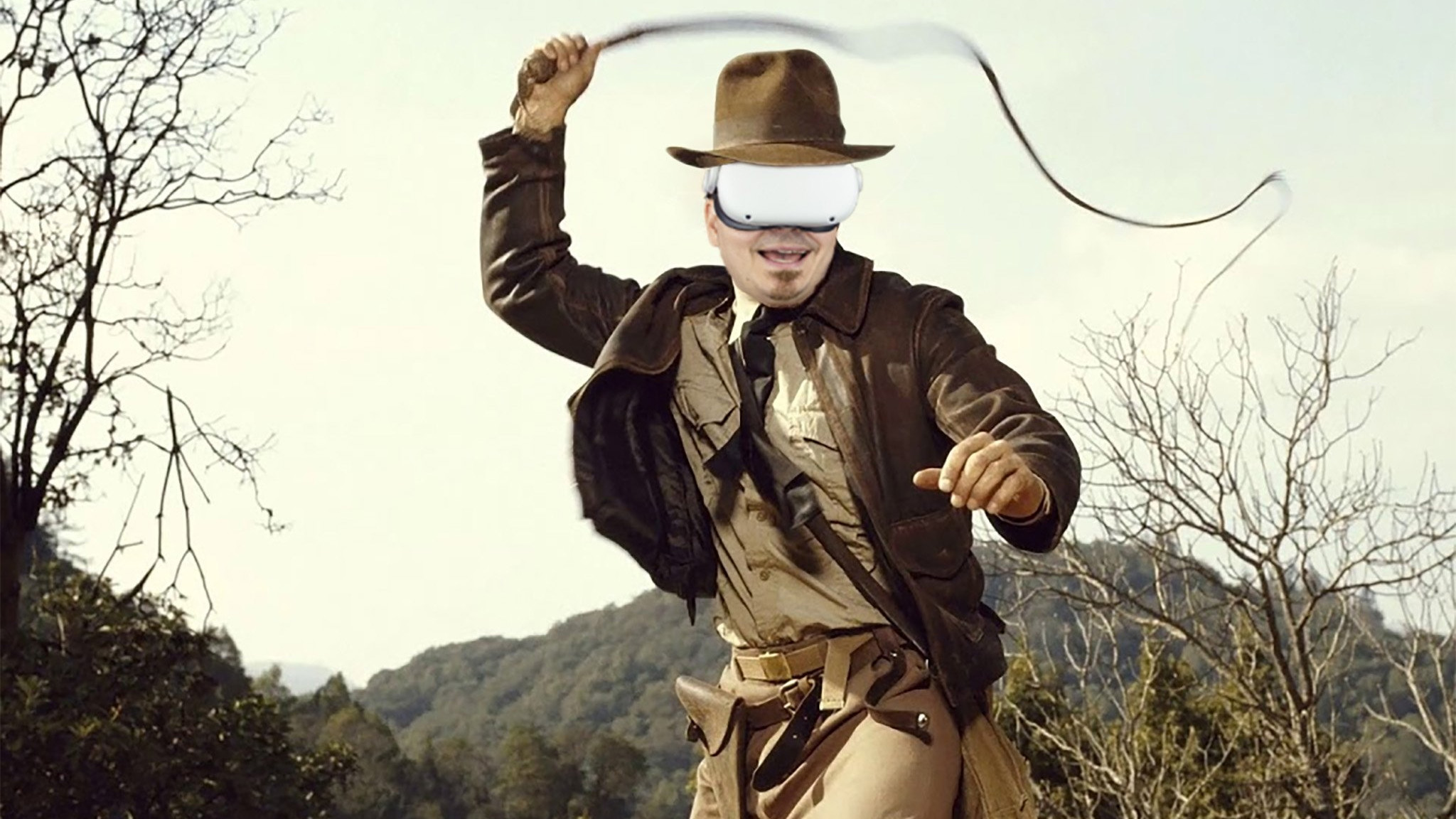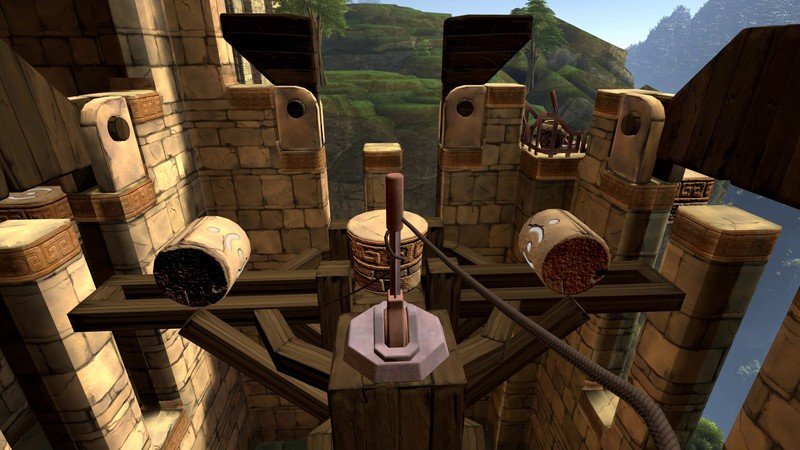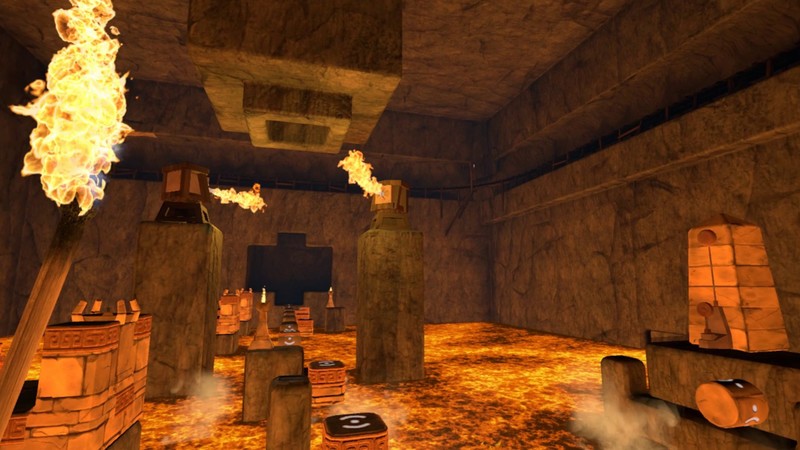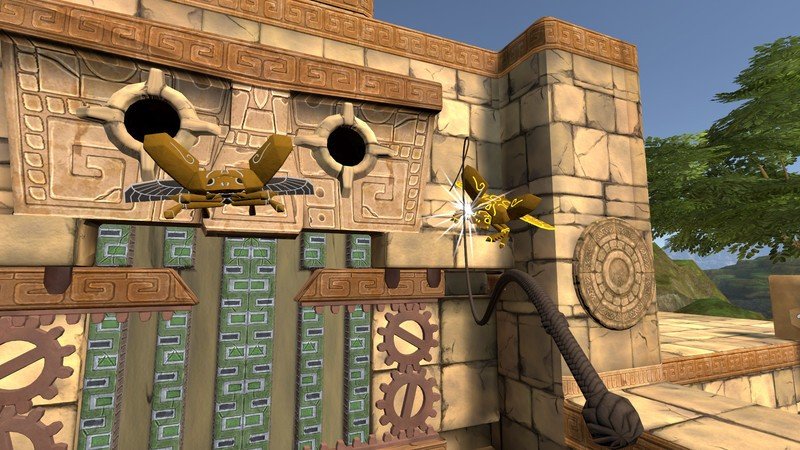
Most VR games are treated as a more personal first-person expression of a pancake game — or one that you play solely on a flat screen — often integrating the same types of virtual movement into the control scheme. But VR wasn't always like this, and Eye of the Temple proves that, with the right level design, it doesn't always have to be going forward.
Eye of the Temple is a physical movement puzzle game at heart. Think of walking simulators like Firewatch or The Witness, where you walk around solving puzzles that fit into a certain narrative, and you'll begin to understand how Eye of the Temple is designed. Maybe the biggest difference — aside from being in VR, of course —is that you'll be physically walking around your room at all times while playing instead of pushing a joystick.
This physical movement concept is something we haven't seen much since the early days of the HTC Vive when roomscale VR was a new concept. Players need a 2m x 2m (6.5 x 6.5ft) space to play Eye of the Temple, as there's no way to virtually move your character. It's a unique way to play that makes it one of the best Quest 2 games ever, although some folks with movement difficulties will have trouble playing it.
This review was originally published on October 14, 2021 and was updated on April 23, 2023 using the native Quest 2 build of the game.
Trust your Guardian

Much as you might expect from an Indiana Jones game, Eye of the Temple sets players on a quest to find hidden treasure in a temple, armed only with a torch and a whip. The whip itself has proper physics applied, so you'll feel like you're cracking an actual whip when you sling it at enemies or grab levers from afar.
The main schtick of Eye of the Temple is that you'll be using actual walking movements within your roomscale boundaries. That means you'll physically be walking from platform to platform, balancing on beams, and walking backward to ensure you don't fall off rolling platforms.
You'll constantly feel like you're about to run into a wall or fall back into your furniture, yet, you never will, thanks to the ingenious level design that fits perfectly into a 2m x 2m space. In other words, you'll really need to trust the Guardian you set up on your Quest instead of worrying about running into something.
Moving blocks will transport you across the virtual world of Eye of the Temple. All you need to do is step on them, and they'll take you to the next point. Stepping off of a block will result in failure and cause you to start back at the previous checkpoint, but those aren't usually too far back.
There's no virtual joystick movement or teleporting here. You'll be doing everything with your own two feet.
As you might expect from any game, what starts out as a simple exercise of walking from moving block to moving block evolves into a more difficult task the further you get into the game. Rolling blocks require you to walk backward in order to stay on top of them. Rotating statues spew fire and require you to duck.
Minecarts, rolling boulders, and timed ceilings that compress you into oblivion also fit right into the expected themes and obstacles that lay in your path to the temple.
As you progress, you'll collect small rubies that can be traded in for larger emerald-like crystals, which open the pathway to the temple. Eye of the Temple is light on story but, nevertheless, presents an intriguing tale of why these crystals are needed for progression.
The base mechanics of Eye of the Temple are such an absolute joy to get accustomed to. During my time with the game, one of my son's friends was over, and they were watching me play. The initial "why do you have to move like that" questions quickly turned into "oh my gosh, this game is awesome" within just a few seconds of play.
Something is mesmerizing and intriguing about physically moving your body through a video game, and it's a novelty that doesn't seem to wear off in the several hours it will take you to make it to the temple.
The puzzles are often clever, but you'll have to be clever about how to move about them to be successful.
The puzzles were challenging enough, and I got stuck several times throughout the game, especially in the sections where you need to time your movements with the movements of crushing blocks or other dangerous obstacles. The real skill of the game is moving yourself the right way rather than the puzzles themselves, in my experience.
Once you complete the game, several collectibles can be garnered by further exploring the temple. As you gain new abilities, you'll have that "eureka!" moment that'll take you back through already-explored areas to find lost treasures. I always enjoy this Metroidvania-esque type of level design, and I imagine anyone else who does will also enjoy how Eye of the Temple is devised.
Given that you'll be standing the entire time, it's likely that longer play sessions won't be common. Thankfully, Eye of the Temple uses a great checkpoint system that never seems to place you too far back.
There's something mesmerizing and intriguing about physically moving your body through a video game, a novelty that doesn't seem to wear off even after several hours.
Movement is the hardest part

The puzzles in Eye of the Temple are regularly interesting and get your noodle thinking, but the real challenge throughout the entirety of the game is moving your body as a video game character would.
Roomscale VR is always a bit tricky because, while it's incredibly unique and can't be experienced any other way than through a VR headset, it's also a bit limiting for some players.
The developer, Rune, has taken great care in the level design and obstacles for Eye of the Temple, ensuring that they're not too physically challenging and, yet, still fit properly in a real 2m x 2m space. But that doesn't mean everyone is going to find these movements easy.
Roomscale VR is always a bit tricky because, while it's incredibly unique and can't be experienced any other way than through a VR headset, it's also a bit limiting for several players. Do you have enough space to move around in? Can you physically move with enough speed or agility to complete the puzzles?
A number of accessibility options are present for players who might experience sickness while standing on moving blocks, but without virtual movement of any kind, some players will simply be shut out of the experience. I miss roomscale-only experiences and would like to see more, but I also recognize that it limits the audience that wants to play them.
I don't want this to be a complaint because I thoroughly enjoy roomscale-only games. This is simply an observation of reality with certain physical space and movement requirements.
On the bright side, now that it's natively on Quest, there's no worrying about getting tangled up in a cable like you would have on most PC VR headsets.
The whip, like its real-life counterpart, can be awkward to use at times.
During gameplay, you'll be using your whip for a surprising number of actions. Sometimes you'll use it as an extension of your hand to reach otherwise unreachable switches. Other times, you'll light it on fire to set a pyre ablaze or to wack enemies out of the air. The whip feels a bit awkward at all times, but, at least in my very limited experience, that's also the case with them in real life.
Should you play it?

If you've got a Quest 2 and at least 2m x 2m of roomscale space, Eye of the Temple will give you a unique experience like no other. It's one of those games that only makes sense in VR and makes even more sense using a standalone headset without a wire tethering it to a PC.
As there's quite a bit of world traversal over the hours you'll be playing it, I can see people getting fatigued or maybe even bored with the concept after a while. Most of the areas are small enough that you won't spend more than 20 minutes or so in each, leading you to constantly wonder what's around the next corner. If you're a puzzle fanatic and love the idea of walking for real in a virtual space, this is going to be one of the best $20 you'll spend on a game this year.







